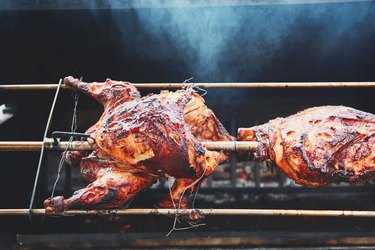
Gathering around a turkey with your friends and family is one of the year's most comforting rituals, but that doesn't mean it always has to be the same turkey. In fact, if you alternate between turkey and ham at the holidays, you might find that buying a smoked turkey occasionally gives you the best of both worlds.
It Doesn't Need to Be Cooked
Video of the Day
A smoked turkey is fully cooked when you buy it, just like a spiral-sliced ham. It's perfectly safe to just open the package, slice the turkey and serve it as is from the refrigerator. If you prefer to eat your smoked turkey hot, that's fine too. In that case, your goal will be to get it up to an appropriate serving temperature without the turkey drying out in the process. There are several ways to do that, so you can pick whichever one is most convenient for you.
Precooked Turkey in Your Oven
The oven is an obvious place to heat your turkey, especially if you're doing a whole one. A smoked turkey's cooking time depends on its weight and the temperature you choose, just as it would with a fresh one. Various brands suggest heating temperatures from 275 to 350 degrees Fahrenheit, with times ranging from a low of 4 to 5 minutes per pound to a high of 10 to 12 minutes per pound. The higher the temperature, the shorter your cooking time will be, and pieces will take less time than a whole bird.
To keep the turkey moist as it reheats, wrap it tightly with foil or seal it inside a roasting bag. The best way to check the temperature is with a thermometer inserted into the thigh of the bird or into the thickest part of a separate breast or thigh in a spot where it won't touch the bone.
The USDA suggests heating all poultry and leftovers to a temperature of 165 degrees Fahrenheit, but a smoked turkey is more like a ham than a fresh bird. The guidance for ham – heat to 140F if it's factory sealed or 165F if it's store packaged – is equally appropriate in this case. Choose the temperature with which you're comfortable.
Reheating In a Countertop Roaster
Your countertop roaster is a fine option for reheating. It behaves like a self-heating roasting pan, so keeping moisture in the bird is less of a concern than it would be in a conventional oven. Place the bird on the rack of your preheated roaster, taking care not to burn yourself on the sides of the cooking well, and heat it until the thermometer shows your chosen temperature of 140F or 165F.
Using Your Microwave
Your microwave can be a useful alternative for smoked wings, smoked drumsticks or a whole or sliced smoked breast. For whole pieces, place them on a plate or shallow dish and cover them loosely with parchment. Heat for 10 to 20 minutes, checking the temperature every 5 minutes. Let the pieces rest for at least 5 minutes before serving, which allows time for the heat to equalize throughout the turkey.
For sliced breast meat, add a few drops of water or broth to the dish and cover it with a lid or a piece of plastic wrap with a couple of small vent holes poked in it with a toothpick or the tip of a knife. Heat it for 1 to 5 minutes depending on how much turkey you're warming at a time.
Cooking Smoked Turkey Legs or Wings
Smoked turkey legs and wings can be reheated exactly the same ways as a breast or a whole bird, but they don't need to be. You can also opt to use them as a flavoring ingredient in a number of slow-cooked dishes, just as you would with a ham bone or smoked ham hock. Try simmering them with sturdy greens such as collards or kale or in hearty dishes with beans or sauerkraut. They add just as much flavor as their pork equivalents and stew down to a lush and tender texture.
Check out this related video from ExpertVillage on Youtube
- Gartner's Meats: Gartner's Smoked Turkeys – Reheating
- Hermann Wurst Haus: How to Reheat a Hickory Smoked Turkey
- Butterball: Fully Cooked Smoked Whole Turkey Breast
- Smithfield Marketplace: Boneless Petite Smoked Turkey Breast
- U.S. Department of Agriculture Food Safety and Inspection Service: Turkey Basics: Handling Cooked Dinners
- U.S. Department of Agriculture Food Safety and Inspection Service: Ham and Food Safety